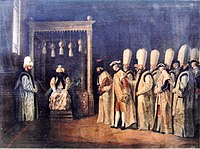| Mustafa III | |||||
|---|---|---|---|---|---|
| Ottoman Caliph Amir al-Mu'minin Custodian of the Two Holy Mosques | |||||
 | |||||
| Sultan of the Ottoman Empire (Padishah) | |||||
| Reign | 30 October 1757 – 21 January 1774 | ||||
| Predecessor | Osman III | ||||
| Successor | Abdul Hamid I | ||||
| Born | 28 January 1717 Edirne Palace, Edirne, Ottoman Empire | ||||
| Died | 21 January 1774 (aged 56) Topkapı Palace, Istanbul, Ottoman Empire | ||||
| Burial | Laleli Mosque, Fatih, Istanbul | ||||
| Consorts |
| ||||
| Issue Among others | |||||
| |||||
| Dynasty | Ottoman | ||||
| Father | Ahmed III | ||||
| Mother | Mihrişah Kadın | ||||
| Religion | Sunni Islam | ||||
| Tughra |  | ||||

Mustafa III (/ˈmʊstəfə/; Ottoman Turkish: مصطفى ثالث Muṣṭafā-yi sālis; 28 January 1717 – 21 January 1774) was the sultan of the Ottoman Empire from 1757 to 1774. He was a son of Sultan Ahmed III (1703–30), and his consort Mihrişah Kadın. He was succeeded by his brother Abdul Hamid I (1774–89).
Mustafa was born at the Edirne Palace on 28 January 1717.[1] His father was Sultan Ahmed III, and his mother was Mihrişah Kadın.[2] He had a full brother named, Şehzade Süleyman. In 1720, a large fifteen day circumcision ceremony took place for Mustafa, and his brothers, princes Süleyman, Mehmed, and Bayezid.[3] In 1730, after the Patrona Halil revolt, led to the deposition of his father Sultan Ahmed III,[4] and the succession of his cousin Sultan Mahmud I, Mustafa, his father, and brothers were all locked up in the Topkapı Palace. In 1756, after the death of his elder half-brother Mehmed, he became heir to the throne.
Mustafa ascended the throne on 30 October 1757, after the death of his cousin Osman III, the son of Sultan Mustafa II.[5]
Soon after his accession to the throne, Mustafa demonstrated a special care for justice. He took a number of measures to increase prosperity in Istanbul. He regulated coinage, built large grain stores, maintained aqueducts, and established a strict fiscal policy.[6] He traveled frequently and checked whether the laws he had enforced were followed.[7]
Mustafa much admired Frederick the Great's generalship, and in 1761 established a peace treaty with Prussia. Frederick wanted an alliance against the Habsburgs, and Mustafa wanted to modernize his state and army. Mustafa preferred recruiting his officers in Berlin, rather than in Paris and London, to re-organize his army. In 1763, the two countries exchanged their diplomats for the first time.[8]
|
Main article: Russo-Turkish War (1768–1774) |

Koca Ragıp Pasha, who remained grand vizier until 1763, pursued a peace policy towards neighboring countries. But the increasing influence of Russia over the Caucasus and its intention to control Poland created tension between the Ottomans and Russia. Ragıp Pasha's successor Muhsinzade Mehmed Pasha also preferred to remain at peace, and Mustafa's insistence on war ("I will find some means of humbling those infidels" [9]) with Russia led to his resignation in 1768. The Sultan expected to gain an easy victory over the Russians, but in fact the Ottomans were unprepared for a long war. During the war, military reforms were undertaken, with the assistance of French officer François Baron de Tott. They included the modernization of artillery corps and the foundation of the Naval Engineering School in 1773. The war was disastrous for the Ottoman Empire. The Russian armies occupied the Crimea, Romania and parts of Bulgaria.[10]
Many monumental buildings including the Fatih Mosque, which was built by Mehmed the Conqueror, were rebuilt from the ground during his reign. In addition, he had built Laleli Mosque complex, and the shore along the Yenikapı filled to set up a new neighborhood. Apart from these, he undertook other construction projects after the earthquakes of 1766,[6] and 1767.[11]

He was a poet, his poetry being written under the pseudonym of Cihangir.[12]
"Yıkılupdur bu cihan sanma ki bizde düzele
Devleti çarh-ı deni verdi kamu müptezele
Şimdi erbab-ı saadette gezen hep hazele
İşimiz kaldı hemen merhamet-i lem yezele."[13]
(Translation)
"This world has ruined, don't even think with us it recovers,
It was the lousy fate that has delivered the power to vulgars,
Now the perfidious ones have populated the Imperial Palace,
It's now the mercy of the everlasting God that runs our business.
Mustafa III had seven known consorts: [14] [15] [16] [17] [18]
Mustafa III had at least two sons: [22] [23]
Mustafa III had at least nine daughters: [24] [25] [26] [27] [22]
Mustafa died of heart attack[29] on Friday,[30] 21 January 1774,[30][31][32] at the Topkapı Palace, and was buried in his own mausoleum located at Laleli Mosque, Istanbul.[33] He was succeeded by his brother Abdul Hamid I.[34] His death left the empire struggling with economic and administrative problems.[35]